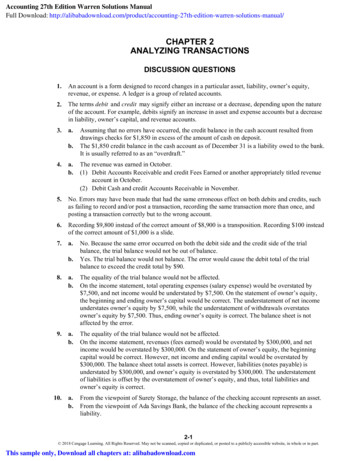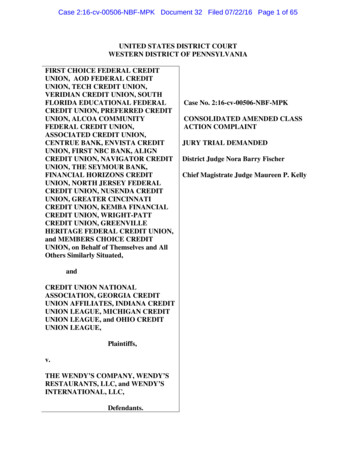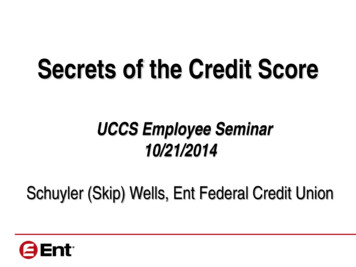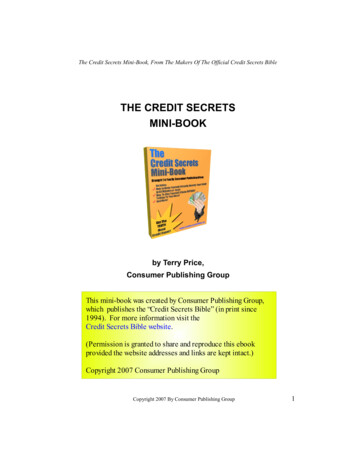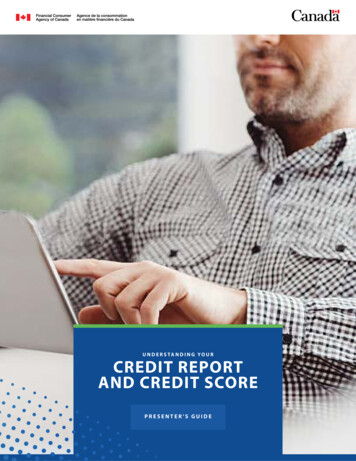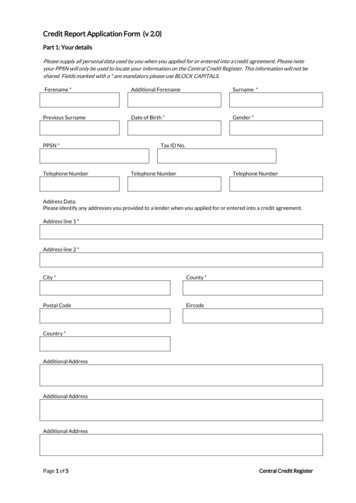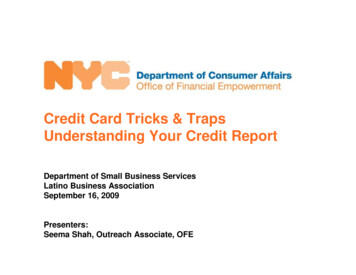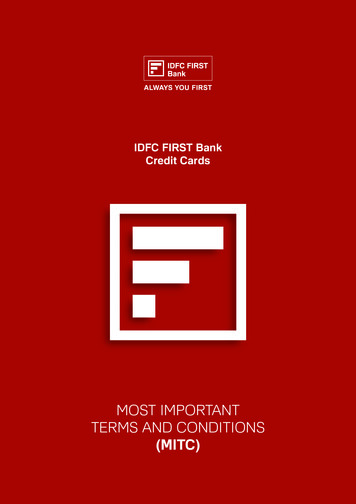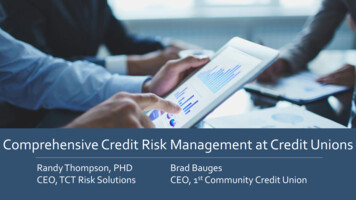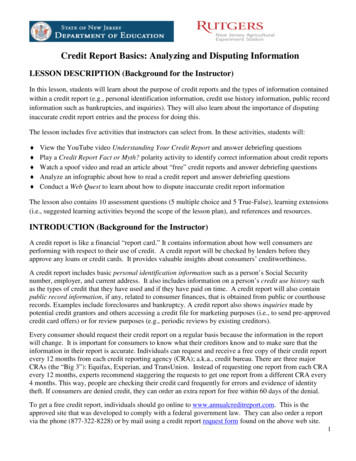
Transcription
Credit Report Basics: Analyzing and Disputing InformationLESSON DESCRIPTION (Background for the Instructor)In this lesson, students will learn about the purpose of credit reports and the types of information containedwithin a credit report (e.g., personal identification information, credit use history information, public recordinformation such as bankruptcies, and inquiries). They will also learn about the importance of disputinginaccurate credit report entries and the process for doing this.The lesson includes five activities that instructors can select from. In these activities, students will: View the YouTube video Understanding Your Credit Report and answer debriefing questionsPlay a Credit Report Fact or Myth? polarity activity to identify correct information about credit reportsWatch a spoof video and read an article about “free” credit reports and answer debriefing questionsAnalyze an infographic about how to read a credit report and answer debriefing questionsConduct a Web Quest to learn about how to dispute inaccurate credit report informationThe lesson also contains 10 assessment questions (5 multiple choice and 5 True-False), learning extensions(i.e., suggested learning activities beyond the scope of the lesson plan), and references and resources.INTRODUCTION (Background for the Instructor)A credit report is like a financial “report card.” It contains information about how well consumers areperforming with respect to their use of credit. A credit report will be checked by lenders before theyapprove any loans or credit cards. It provides valuable insights about consumers’ creditworthiness.A credit report includes basic personal identification information such as a person’s Social Securitynumber, employer, and current address. It also includes information on a person’s credit use history suchas the types of credit that they have used and if they have paid on time. A credit report will also containpublic record information, if any, related to consumer finances, that is obtained from public or courthouserecords. Examples include foreclosures and bankruptcy. A credit report also shows inquiries made bypotential credit grantors and others accessing a credit file for marketing purposes (i.e., to send pre-approvedcredit card offers) or for review purposes (e.g., periodic reviews by existing creditors).Every consumer should request their credit report on a regular basis because the information in the reportwill change. It is important for consumers to know what their creditors know and to make sure that theinformation in their report is accurate. Individuals can request and receive a free copy of their credit reportevery 12 months from each credit reporting agency (CRA); a.k.a., credit bureau. There are three majorCRAs (the “Big 3”): Equifax, Experian, and TransUnion. Instead of requesting one report from each CRAevery 12 months, experts recommend staggering the requests to get one report from a different CRA every4 months. This way, people are checking their credit card frequently for errors and evidence of identitytheft. If consumers are denied credit, they can order an extra report for free within 60 days of the denial.To get a free credit report, individuals should go online to www.annualcreditreport.com. This is theapproved site that was developed to comply with a federal government law. They can also order a reportvia the phone (877-322-8228) or by mail using a credit report request form found on the above web site.1
Each person’s credit report is different. Some are long (e.g., older adults with a long history of credit useand multiple creditors) and some are short (e.g., young adults just starting to use credit). In addition, creditreport layouts vary among CRAs. Credit reports can also vary for the same person across the three majorCRAs. This is because different CRAs vary with respect to which creditors they choose to do business with(i.e., which creditors they receive consumers’ payment history from and report consumers’ credit paymenthistory to). For example, a specific creditor may decide to report and receive information from Equifax, butnot from Experian or vice versa. Therefore, CRAs will likely have different pieces of information about anindividual consumer in their reports. Credit scores based on credit report content will also likely vary.Once consumers receive their credit report, it is important to review it carefully. There are codes andabbreviations in the report that need to be reviewed and key terms such as “current” or “paid as agreed,”which mean that someone has made timely payments to creditors. Specific pieces of information thatconsumers should review in a credit report include: the accuracy of their personal identificationinformation, notations about late payments (usually reported in increments of 30, 60, 90, and 120 dayslate) and collection activity by creditors, information from public records (e.g., mortgage foreclosures andbankruptcies), the status of credit accounts that were closed (to make sure that they are reported correctly),and evidence of identity theft (e.g., large debt balances or active accounts that were never opened).Another item to check is inquires made to see a credit report. Hard inquires occur when consumers requestnew credit and can affect their credit score. Soft inquiries are made when a credit report is reviewed formarketing or creditor review purposes and they don’t affect a person’s credit score. People with negativeinformation in their credit file also want to check that it is removed after 7 years (10 years for bankruptcy).Under the Fair Credit Reporting Act, CRAs and the creditors that provided them with credit paymentinformation about consumers are responsible for correcting credit report errors. If there is incorrectinformation in their credit report, consumers should report the error(s) to the CRA that sent it (i.e.,Experian, Equifax, or TransUnion). Forms for this purpose are typically sent with credit reports that arerequested and received via U.S. mail and are also available online. Consumers should complete the formand attach copies of relevant documentation to support their case. CRAs are required to investigate thedisputed information and to report back to consumers within a certain time frame, typically about 30 days.The Federal Trade Commission (FTC) has good information on how to dispute errors in a credit report.Having an accurate credit report is important because it is accessed by institutions that make lending andother financial decisions. A credit report can be accessed, not only by potential credit card issuers, but bylandlords, sellers of major items such as cars, homes, and furniture, potential employers, and insurancecompanies. If a credit report has been used to deny consumers a job or a rental unit, they must be advised ofthis. Some states have passed laws that limit the use of credit reports in making hiring decisions.Millions of credit reports contain errors such as co-mingled information from another person, debtswrongly listed as being delinquent, or fraudulent accounts opened as a result of identity theft. Some ofthese errors are serious enough to lower credit scores (a three-digit number that is calculated by a formulausing information contained within a person’s credit report) enough to result in increased borrowing costsor other negative outcomes. That is why consumer should check their credit reports regularly.To summarize by returning to the report card analogy, every day millions of people are “graded” withcredit reports. Credit scores are like a GPA. Like school grades, credit “grades” have a powerful impact onpeople’s future. They influence whether or not consumers are approved to borrow money and the interestrate that will be charged if they are. The better people’s credit history, the better chance they have ofobtaining a loan or credit card and lower-cost credit that can save thousands of dollars of interest over time.Note: Related information about credit scores can be found in the New Jersey Department of EducationStandard 9.1.12.C6 lesson plan #3, Know the Score: Credit Score Modeling and Impacts.2
OBJECTIVESStudents will be able to: Describe the difference between a credit report and a credit score. List five or more pieces of information contained within a credit report. Distinguish between facts and myths about credit reports. Compare and contrast the free central credit report request web site with alternative providers. Describe the three ways that a free credit report can be obtained (online, by phone, and by U.S. mail). Describe the steps that need to be taken when a credit report has inaccurate information.NEW JERSEY PERSONAL FINANCIAL LITERACY STANDARD Standard 9.1.12.C.5: Analyze the information contained in a credit report and explain the importance ofdisputing inaccurate entries.See LFAQ.htm#gradcredit er/91.pdf for information about Standard 9.1TIME REQUIRED45 to 180 minutes (depending upon student progress and content depth and number of activities used)MATERIALS YouTube Video (2:19): Understanding Your Credit Report (MyFICO):https://www.youtube.com/watch?v kWgLooCkgx4 and video debriefing questions Credit Report Fact or Myth? polarity activity handout YouTube Video (0:45): Free Credit Report Commercial (FTC spoof video):https://www.youtube.com/watch?v 4GC9dobzEKc Article: Get a Free Credit Report Without Getting Scammed: ee-credit-report-960500 (Back-Up Articles: Free Credit Reports That Aren’t ee-credit-reports-that-arent-free and ‘Free’ CreditReports Sometimes Aren’t Free: http://abcnews.go.com/Business/story?id 3923518&page 1 ) How to Read Your Credit Report Like a Pro rt-like-apro#.WZ2DOYfrs5u and activity handout Web Quest: How to Dispute an Inaccurate Credit Report Credit Report Quiz (ASSESSMENT)Teachers are encouraged to use as many of the student learning activities as time permits to provide afuller understanding of credit reports. The activities can also be used for extra credit assignments,homework, or after-school activities.3
PROCEDURE1. Ask students to explain the difference between a credit report and a credit score.Answers will likely vary. Review the difference with an analogy to student grades. A credit report is adetailed report of a person’s credit use performance (history). It is similar to a “report card,” which isa detailed report of a student’s school performance. Both report cards and credit reports generallycontain codes that are used to explain information. A credit score is a three-digit number that iscalculated using information contained within a credit report. It is similar to a grade point average(GPA), which is based on student performance data contained within a report card.2. Activity 1: Show the MyFICO video Understanding Your Credit Report (see the video link on page 3)and debrief the following questions (based on video content) with students:What is a credit report?A credit report is a detailed report of a person’s credit use history that is prepared by a credit reportingagency (a.k.a., credit bureau). Credit reports are used by creditors to make lending decisions. Includedin an individual’s credit report are: personal information (name, address, employer), detailed creditaccount information (e.g., bill payment history, credit limit, current balance), information from publicrecords (e.g., wage garnishments and bankruptcy), and a list of credit account inquiries. Negativeinformation generally remains in a credit report for seven years (10 years for bankruptcy filings). Underthe Fair and Accurate Credit Transactions Act (FACTA), consumers are entitled to request one freecredit report annually from each of the “big three” credit bureaus via www.annualcreditreport.com.What are the three largest credit reporting agencies (a.k.a., credit bureaus) in the United States?Experian, Equifax, and TransUnion are known as the “Big 3” because they are the largest creditreporting agencies (CRAs) in the country. It should be noted that these companies are not the onlyCRAs, however. In addition, there are dozens of smaller CRAs that provide regional or industryspecific credit reports. For example, there are so-called specialty credit reporting agencies that providereports about tenant history, insurance claims, and check-writing history.Where do credit reporting agencies (a.k.a., credit bureaus) get credit history information?Credit reports compile data about consumers’ past and current use of credit from a variety of sources.Borrowers’ past record of payment of debts is known as their credit history. Credit history informationsources for credit reports include financial institutions (e.g., banks and credit union), credit card issuers,retailers, mortgage lenders, collection agencies, and public court records (e.g., bankruptcy).How do lenders use information contained within a credit report?Many lenders today only review credit scores, which are three-digit numbers calculated by usingformulas that weight various pieces of information contained within a credit report. Bill paymenthistory and amount of credit used (both shown in credit reports) are key factors. Therefore, it is veryimportant to review credit reports regularly to make sure that they are accurate. Lenders use creditreport information to determine whether or not to issue credit to consumers and to determine whatinterest rate to charge. Generally, consumers with a better credit history receive more favorable loanterms than those with blemishes in their credit report (e.g., late payments and charged-off debts).4
What information is contained within a credit report?A credit report includes basic personal identification information such as a person’s Social Securitynumber, employer, and current address. It also includes information on consumers’ credit use historysuch as the types of credit that they have used and timeliness of payments. Credit reports also containpublic record information, if any, related to consumer finances obtained from public or courthouserecords. Examples include foreclosures and bankruptcy. A credit report also shows inquiries made bypotential credit grantors and others accessing a credit file for marketing or review purposes.What are tradelines in a credit report?Tradelines are described in the video as “the heart of a consumer’s credit report.” The term “tradeline”is an industry term that refers to actual consumer accounts that are listed in a credit report. Informationabout these consumer accounts is collected by credit reporting agencies from the creditors that they dobusiness with. Specific information included within tradelines includes the name of credit accounts, thedate when accounts were opened, the loan amount, the current balance, and payment history (e.g.,notations for late payments and words like “current” or “paid as agreed” for on time payments).What are inquiries in a credit report?The inquiries section of a credit report lists specific times that a consumer’s credit report was reviewedand the name of the entity that conducted the review. Hard inquires occur when consumers,themselves, have requested new credit and can affect their credit score. Soft inquiries are made when acredit report is reviewed externally by others for marketing purposes (e.g., in advance of receiving apre-approved credit card offer) or by existing creditors, and they don’t affect a person’s credit score.What is a credit score?Credit scores are a three-digit number derived from information contained within a credit report.Ranging from 300 to 850 (for FICO scores), lenders use credit scores as a measure of a person’screditworthiness and to determine interest rates charged for a loan or credit card. The higher a creditscore number (e.g., 760 versus 550), the better a loan risk an individual is judged to be. Credit scoresincorporate a number of key factors that have been shown to be associated with debt repayment.3. Activity 2: Distribute the 10-question Credit Report Fact or Myth? activity handout to have studentsidentify true and false information about credit reports. Read each question and have students decidewhether the statement is correct (hold up the Fact card) or false (hold up the Myth card). The Fact andMyth cards should be printed on different colors of paper or on different color index cards. See thesample below. Debrief each question using descriptions of the correct answers found below.5
A person’s credit score will drop if they make a request to see their credit report.MYTHThere is no credit score penalty for consumers who check their own credit reports. This type of creditreport inquiry is referred to as a “soft inquiry” and it does not impact credit scores.To request a copy of their credit report, consumers must provide their Social Security number.FACTTo request a credit report, consumers must provide some sensitive personal information (date of birthand Social Security number). These key pieces of data are needed by credit reporting agencies to pullthe correct information about their credit history.U.S. consumers can request a free credit report annually from the “Big 3” credit bureaus.FACTConsumers can request free credit reports via the web site www.annualcreditreport.com. This is the website that was developed to comply with a federal government law. They can also order a report via thephone (877-322-8228) or by mail using a credit report request form found on the above web site.Consumers must request credit reports from each of the “Big 3” credit bureaus at the same time.MYTHWhile it is certainly possible to simultaneously request credit reports from each of the “Big 3” creditreporting agencies (a.k.a., credit bureaus), consumers don’t have to. Instead of requesting credit reportsfrom each CRA every 365 days (12 months), experts recommend staggering the requests to get onereport from a different CRA every four months. This way, someone is checking their credit cardfrequently for errors and evidence of identity theft.Negative information, such as late payments, stays in a credit report for five years.MYTHNegative information, such as late payments, charged-off accounts, car loan defaults and repossession,home foreclosures, and completed Chapter 13 bankruptcies, typically remains in a person’s credit reportfor seven years. The time limit for reporting Chapter 7 bankruptcies is even longer: up to 10 years.Negative information can come from current or previous credit accounts. Older negative creditinformation has less impact on credit scores than more recent negative data.Paying off a debt that had late payments does not automatically remove negative information.FACTNegative information about late payments does not automatically get removed from credit reports whenconsumers catch up on making payments. However, it may be possible for consumers to contact theiroriginal creditor (e.g., the retail store whose credit card they used and fell behind on) and request thatthe creditor remove the late payment notation from their credit history. Negotiation strategies work bestif the late payment in question was a one-time event and not a regular pattern of behavior.Credit reporting agencies (a.k.a., credit bureaus) make lending decisions such as approving loans.MYTHCredit reporting agencies do not make lending decisions. They simply provide data to potential lenders.6
Credit reports are free to people who have been denied credit within the past 60 days or arevictims of fraud such as identity theft.FACTUnder the Fair Credit Reporting Act, consumers in the two situations noted above (i.e., people deniedcredit within the past 60 days and fraud victims) are entitled to a free credit report in addition to theirfree annual credit report. Other consumers who are eligible for an additional free credit report are thosewho are unemployed but plan to seek employment within 60 days, those receiving public assistance,and those who reside in states (including New Jersey) that have laws requiring free credit reports.Credit reports include a person’s race and religion.MYTHPersonal characteristics that are unrelated to consumers’ use of credit are not included in credit reports.This includes race, religion, marital status (although this may become evident through a listing of creditaccounts that are held jointly with others), political party affiliation, and medical history.Credit reporting agencies (a.k.a., credit bureaus) typically have about 30 days to respond toconsumer disputes about information in their credit report.FACTUnder the Fair Credit Reporting Act, credit reporting agencies (CRAs) typically have about 30 days toinvestigate and respond to consumer disputes about information contained within their credit reports.CRAs will investigate the dispute with the organization (e.g., a retailer) that originally provided theCRA with a consumer’s credit history information. The information provider then researches the caseand reports back to the CRA. Consumers should expect to receive a written report about the results ofthe investigation. The CRA must also provide a free credit report if the dispute results in a change.4. Activity 3: Show the Federal Trade Commission video Free Credit Report Commercial:https://www.youtube.com/watch?v 4GC9dobzEKc. Then have students read a print or online versionof an article about “free” credit cards with “strings” attached such as Get a Free Credit Report WithoutGetting Scammed: ree-credit-report-960500. Askstudents to explain the take-away message from both the video and the article.The take-away message from the video and article is that there is only one truly free source of creditreports: www.annualcreditreport.com. This web site was created as a result of a federal governmentlaw, the Fair and Accurate Credit Transactions Act (FACTA), that gives consumers the right to requesta free credit report every year (defined as a 365-day time period). The video is a spoof of commercialsthat encourage consumers to go elsewhere for credit reports. Some of these other web sites trick peopleinto paying for credit reports or expensive credit monitoring services with monthly fees.5. Activity 4: Direct students to the SunTrust How to Read Your Credit Report Like a Pro rt-like-apro#.WZ2DOYfrs5u and distribute the accompanying activity handout. Have students work together insmall groups to answer the questions listed below about the content of the infographic. Debrief theanswers to the questions about credit reports with the total class.7
What are five pieces of personal information found in a credit report?The five pieces of data are full name, address, name of employer, date of birth, and Social Securitynumber.What are two pieces of personal information that are not a factor in credit scores?The two pieces of data are age and marital status.What five pieces of credit use information are found in credit report tradelines?The five pieces of data are type of account, date opened, credit limit or loan amount, account balance,and loan history.What type of information found in a credit report accounts for 35% of a person’s FICO creditscore?Payment history, which is the largest single factor (35% formula weighting) in the calculation of FICOcredit scores. Other factors used in the calculation of credit scores have a lower percentage weighting.For example, having a mix of different credit types has a 10% FICO credit score weighting.What are three examples of revolving accounts?Bank credit cards (e.g., Visa and Mastercard), retail store credit cards, and home equity lines of credit.What are three examples of installment accounts?Home mortgages, student loans, and auto loans.How long can credit inquiries stay on a person’s credit report?An inquiry (request to access a person’s credit history) can appear in a credit report for 12 to 24months. Inquiries include account monitoring inquiries, promotional inquiries, and “hard inquiries”made when consumers apply for a new line of credit and a potential lender reviews their credit history.What are three pieces of public record information found in a credit report?Examples shown in the infographic are bankruptcies, tax liens, and judgments.How long can bankruptcies remain listed in a credit report?10 years.How long can collections on past-due accounts remain listed in a credit report?7 years.According to a survey, what fraction (%) of Americans have never checked their credit report?26 percent according to a May 2015 survey by Bankrate.6. Activity 5: Distribute the Web Quest: How to Dispute an Inaccurate Credit Report activity handout andask students to use an online search engine (e.g., Google, Bing) and search for words such as “creditreport errors,” “correcting credit report errors,” “inaccurate credit reports,” and “credit report disputes.”Give students about 15 to 20 minutes to find, read, and summarize information from unbiased sources(e.g., the Federal Trade Commission, Federal Reserve Board, and non-profit consumer organizations)that are not selling credit report-related services. Call the entire class back together and debrief theactivity and what was learned about disputing inaccurate credit report information.8
Student answers will vary but should include the fact that credit reporting agencies will contact theoriginal creditors that consumers have a dispute over information with. The time frame to resolvedisputes is approximately 30 days unless a CRA considers a dispute to be frivolous. Technically,response time can take up to 45 days. The Fair Credit Reporting Act requires CRAs to investigate aconsumer’s dispute with the original creditor within 30 days after the CRA gets the disputedocumentation. The law then allows an additional five business days for a CRA to respond to theconsumer. The 45 day upper limit estimate takes into consideration weekends and mail delivery time.CLOSUREAsk students if they have any remaining questions about credit reports. Remind them that, like report cards,credit reports can have big impact on their future. Personal behaviors matter for both types of reports. Justlike it is important to study to get good grades and lots of As on a report card, it is also important to repaydebts promptly to maintain a good credit history and avoid any negative information (e.g., late payments).GLOSSARYBankruptcy- A legal process where a judge and court-appointed trustee review the income, assets, anddebts of indebted individuals or households to make decisions about debt repayment and debt discharges.Federal and state bankruptcy laws provide a “fresh start” to people who have become overwhelmed bydebt. Bankruptcy is generally considered a “last resort” method to deal with an overwhelming amount ofdebt because it is a very negative notation in credit reports and severely damages credit scores.Credit Limit- The maximum amount of money that a consumer is allowed to borrow as a line of credit. Anexample is a 1,000 limit on a credit card.Credit Report- A detailed report of a person’s credit use history that is prepared by a credit reportingagency (a.k.a., credit bureau). Credit reports are used by creditors to make lending decisions.Credit Reporting Agency (a.k.a., Credit Bureau)- A business that receives and distributes informationabout the credit use experience of individuals. Information is collected from and shared with businessessuch banks and retailers. There are three major CRAs (the “Big 3”): Equifax, Experian, and TransUnion.Credit Score- A three-digit number that is derived from information contained within a credit report. FICOcredit scores range from 300 (worst) to 850 (best). Lenders use credit scores as a measure of a person’screditworthiness and to determine the interest rates charged for a loan or credit card.Current (Paid as Agreed)- Words used in a credit report to indicate that a credit account is in goodstanding and that consumers have been making payments according to the terms of their loan agreement.These words are the best status that can be listed in the tradelines section of a credit report. They mean thatconsumers have been paying at least their minimum required payment by their billing statement due date.Foreclosure- The legal process used by mortgage lenders to take possession of a mortgaged property (e.g.,a single-family home or condo) when borrowers fail to make mortgage payments. After foreclosure, theproperty belongs to the bank and the homeowner will eventually have to leave the premises. Foreclosureprocesses vary from state to state with respect to disclosures and time limits for homeowners to pay backwhat they owe (e.g., court costs and unpaid principal and interest) to avoid the loss of their home.9
Identity Theft- The use of someone’s personal identification information (e.g., name, Social Securitynumber, and bank or credit account numbers) to commit a crime (e.g., steal money from a bank accountand make fraudulent purchases). Checking a credit report regularly is a recommended strategy to look forevidence of identity theft such as unauthorized credit accounts or purchases.Inquiries- Requests that are made to see a person’s credit report. Hard inquires occur when consumersrequest new credit and can affect their credit score. Soft inquiries are made when a credit report is reviewedfor marketing or creditor review purposes and they don’t affect a person’s credit score.Judgment- A decision made by a court of law to settle a dispute between two parties. Successful judgmentcases often result in a plaintiff
A credit report is a detailed report of a person's credit use history that is prepared by a credit reporting agency (a.k.a., credit bureau). Credit reports are used by creditors to make lending decisions. Included in an individual's credit report are: personal information (name, address, employer), detailed credit

